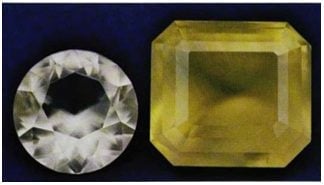Prehnite Value, Price, and Jewelry Information
Prehnite is popular as a cabochon material among hobbyists because of its lovely green and blue-green to yellow colors. Completely transparent material is extremely rare but might be found in crystals from Asbestos, Quebec. Yellowish to greenish translucent material from Australia has been faceted and makes a striking cut gemstone with a rich color and interesting appearance, with a soft, velvety look. Some catseye stones have also been reported. Material from Scotland has yielded cuttable fragments, but such faceted gems are rather small (under 5 carats).
1 Minute Read
Prehnite is popular as a cabochon material among hobbyists because of its lovely green and blue-green to yellow colors. Completely transparent material is extremely rare but might be found in crystals from Asbestos, Quebec. Yellowish to greenish translucent material from Australia has been faceted and makes a striking cut gemstone with a rich color and interesting appearance, with a soft, velvety look. Some catseye stones have also been reported. Material from Scotland has yielded cuttable fragments, but such faceted gems are rather small (under 5 carats).
Start an IGS Membership today
for full access to our price guide (updated monthly).Prehnite Value
Optics: a= 1.611—1.632; β=1.615-1.642; γ=1.632-1.665.
Biaxial (+), 2V = 65-69°. Usually refractometer gives shadow edge about 1.63.
Note: Faceted material from Australia, indices 1.618/1.625/1.648; birefringence 0.030. Values for optical constants increase with increasing iron content.
Occurrence: A low-temperature mineral occurring by deposition from ground waters in basaltic rocks associated with zeolites; hydrothermal crystals, in cavities in acid igneous rocks; in serpentine rocks due to late-stage mineralization.
California; Colorado; Michigan; Massachusetts; Connecticut.
France; Italy; Austria; Germany; Russia; Czech Republic; Slovakia; South Africa; Pakistan; New Zealand.
New Jersey: in basalts, associated with zeolites.
Fairfax Quarry, Centreville, Virginia: fine green material.
Asbestos, Quebec, Canada: in acidic dikes, in crystals up to 3 inches long (colorless).
Scotland: facetable.
Australia: facetable.
Comments: Prehnite is popular as a cabochon material among hobbyists because of its lovely green and blue-green to yellow colors. Completely transparent material is extremely rare but might be found in crystals from Asbestos, Quebec. Yellowish to greenish translucent material from Australia has been faceted and makes a striking cut gemstone with a rich color and interesting appearance, with a soft, velvety look. Some catseye stones have also been reported. Material from Scotland has yielded cuttable fragments, but such faceted gems are rather small (under 5 carats).
Name: After Colonel Hendrik von Prehn, who first found the material on the Cape of Good Hope.
Joel E. Arem, Ph.D., FGA
Dr. Joel E. Arem has more than 60 years of experience in the world of gems and minerals. After obtaining his Ph.D. in Mineralogy from Harvard University, he has published numerous books that are still among the most widely used references and guidebooks on crystals, gems and minerals in the world.
Co-founder and President of numerous organizations, Dr. Arem has enjoyed a lifelong career in mineralogy and gemology. He has been a Smithsonian scientist and Curator, a consultant to many well-known companies and institutions, and a prolific author and speaker. Although his main activities have been as a gem cutter and dealer, his focus has always been education. joelarem.com
Related Articles
Black Diamond Value, Price, and Jewelry Information
Chameleon Diamond Value, Price, and Jewelry Information
Gray Diamond Value, Price, and Jewelry Information
Green Diamond Value, Price, and Jewelry Information
Latest Articles
Morganite Buying Guide
How Do Amethysts Form?
Rhodizite Value, Price, and Jewelry Information
Pearl Treatments and Enhancements
Never Stop Learning
When you join the IGS community, you get trusted diamond & gemstone information when you need it.
Get Gemology Insights
Get started with the International Gem Society’s free guide to gemstone identification. Join our weekly newsletter & get a free copy of the Gem ID Checklist!
